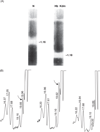Transglutaminase-mediated remodeling of the human erythrocyte membrane skeleton: relevance for erythrocyte diseases with shortened cell lifespan
- PMID: 22220479
- PMCID: PMC3313834
- DOI: 10.1002/9781118105771.ch9
Transglutaminase-mediated remodeling of the human erythrocyte membrane skeleton: relevance for erythrocyte diseases with shortened cell lifespan
Figures










Similar articles
-
Tissue transglutaminase (TG2) facilitates phosphatidylserine exposure and calpain activity in calcium-induced death of erythrocytes.Cell Death Differ. 2007 Oct;14(10):1842-4. doi: 10.1038/sj.cdd.4402193. Epub 2007 Jul 6. Cell Death Differ. 2007. PMID: 17612588 Free PMC article. No abstract available.
-
Tissue transglutaminase and its role in human cancer progression.Adv Enzymol Relat Areas Mol Biol. 2011;78:247-93. doi: 10.1002/9781118105771.ch6. Adv Enzymol Relat Areas Mol Biol. 2011. PMID: 22220476 Review. No abstract available.
-
Transglutaminase 2 at the crossroads between cell death and survival.Adv Enzymol Relat Areas Mol Biol. 2011;78:197-246. doi: 10.1002/9781118105771.ch5. Adv Enzymol Relat Areas Mol Biol. 2011. PMID: 22220475 Review. No abstract available.
-
Physiopathological roles of human transglutaminase 2.Adv Enzymol Relat Areas Mol Biol. 2011;78:47-95. doi: 10.1002/9781118105771.ch2. Adv Enzymol Relat Areas Mol Biol. 2011. PMID: 22220472 Review. No abstract available.
-
Osmotic resistance of high-density erythrocytes in transglutaminase 2-deficient mice.Biochem Biophys Res Commun. 2002 Mar 15;291(5):1123-7. doi: 10.1006/bbrc.2002.6558. Biochem Biophys Res Commun. 2002. PMID: 11883932
Cited by
-
Calcium in red blood cells-a perilous balance.Int J Mol Sci. 2013 May 8;14(5):9848-72. doi: 10.3390/ijms14059848. Int J Mol Sci. 2013. PMID: 23698771 Free PMC article. Review.
-
Measurement of posttransfusion red cell survival with the biotin label.Transfus Med Rev. 2014 Jul;28(3):114-25. doi: 10.1016/j.tmrv.2014.03.003. Epub 2014 Apr 5. Transfus Med Rev. 2014. PMID: 24969019 Free PMC article. Review.
References
-
- Turner PM, Lorand L. Complexation of fibronectin with tissue transglutaminase. Biochemistry. 1989;28:628–635. - PubMed
-
- LeMosy EK, Erickson HP, Beyer WF, Jr., Radek JT, Jeong JM, Murthy SN, Lorand L. Visualization of purified fibronectin-transglutaminase complexes. J. Biol. Chem. 1992;267:7880–7885. - PubMed
-
- Hang J, Zemskov EA, Lorand L, Belkin AM. Identification of a novel recognition sequence for fibronectin within the NH2-terminal beta-sandwich domain of tissue transglutaminase. J. Biol. Chem. 2005;280:23675–23683. - PubMed
Publication types
MeSH terms
Substances
Grants and funding
LinkOut - more resources
Full Text Sources
Medical
